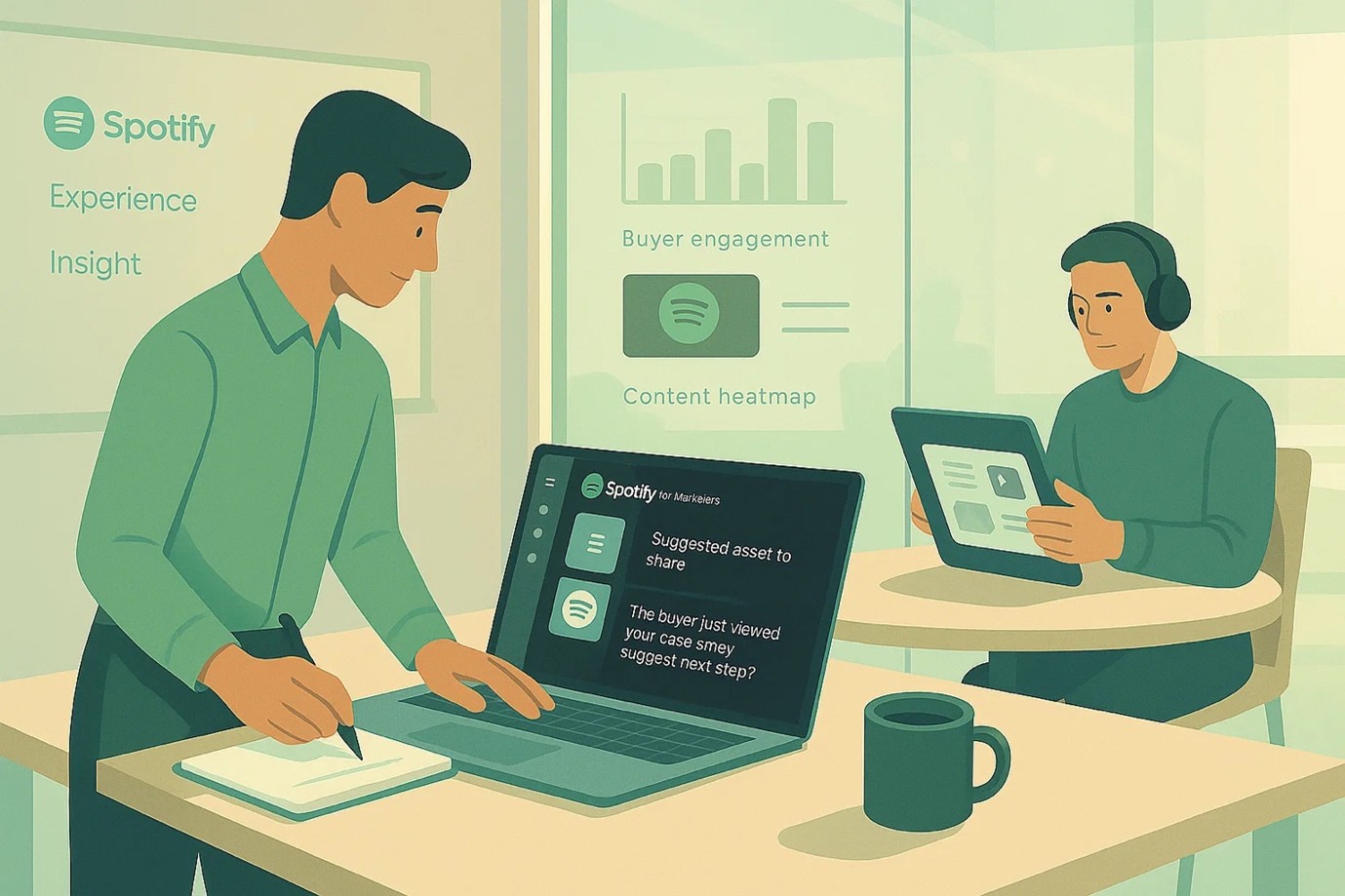July 21, 2025

P.S. I’m a heavy Spotify user. My annual Wrapped regularly clocks over 80,000 minutes a year. Whether I’m at the gym, commuting, or just taking a walk, Spotify is always playing in the background. That’s why I’m using it as a metaphor here.
Think back to the first time you opened Spotify on your phone.
A clean search bar, “Discover Weekly” tailored to your taste, one-tap playlists, and the freedom to skip anything that doesn’t click. Within minutes, you felt in control—and hooked (maybe even already dancing).
Today’s B2B buyers expect the same experience: intuitive, self-directed, and hyper-personal. But most enterprise sales motions still feel like flipping through dusty CD binders in old records stores—while the buyer waits for a streaming link.
Today’s buyers don’t just compare vendors and technology, which is increasingly becoming commoditised—they compare experiences. Your sales team isn’t just up against competitors. They’re up against Netflix, Spotify, and Amazon.
When a buyer can binge-watch a whole season or listen to an entire audiobook with no friction, why should they sit through a 30-slide deck to understand your product?
Here’s what the data shows:
This represents the experience gap. Most sales motions were built for a world where the seller leads. But today, the buyer is in control—and they’re moving faster than your process can keep up. Buyers expect a sales journey that works like their favorite apps: fast, personal, and easy to navigate. Instead, what they often get is: outdated content portals, bulky PDFs generic outreach messages and a lot of waiting.
Instead, they want the Spotify feeling: autonomy, smart recommendations and low-effort discovery that just works.
1. One-Tap Access: Frictionless Self-Service
Spotify hides complexities of individual song profiles and ‘what to play’ next behind a single play button. You open the app, tap once, and the music plays. No forms. No filters. No guesswork. It’s designed to remove friction from choice. Even the UX—minimalist, mobile-first—is built around speed to satisfaction.
Likewise, Twimbit Vault’s content feed and conversational AI uses account context—industry, deal stage, persona—to surface only what matters. No more scrolling through 200 slides; the user clicks once and lands on an interactive microsite built from your best proof points. That satisfies the 75 % who crave rep-free exploration while guiding them toward high-confidence next steps.
2. Personalization That Pays
Spotify’s “Discover Weekly” gives you new music every Monday—songs you didn’t ask for but end up loving. It learns what you like. It finds patterns. It serves up gems you wouldn’t have found on your own. In sales, that replay is buyer trust—and retainers. Fast-growing companies now derive 40% more revenue from personalization than slower rivals.
In the same essence, Twimbit Buddy’s generates AI-based narratives (“Here’s why CFO Lina cares about cash-flow accuracy”) wraps them into call plans and emails. It helps reps quickly understand how to position the solution for different buyer roles—what each one cares about, where to focus the pitch, and how to avoid generic messaging.
3. Continuous Discovery, Not Campaign Bursts
Spotify’s algorithm almost never sleeps; neither should your insight engine. Every skip, replay, and playlist save feeds the algorithm. The more you use it, the better it gets. Sales enablement often ends at content upload. There’s no closed loop. No visibility into what lands, what gets ignored, and what moves deals.
That’s the gap we close. Our analytics track what content gets opened, which stats drive engagement, and what timing turns views into conversations. Over time, this data helps refine what works—not just for one deal, but across the pipeline.
Great selling isn’t built on campaigns. It’s built on continuous discovery, powered by feedback.
Every CRO knows the pipeline doesn’t just depend on rep performance—it hinges on buyer perception. In a world where expectations are constantly shaped by big tech such as Spotify and Amazon, outdated processes don’t just create friction—they create risk of falling behind. Here's how to build a system that meets modern buyers where they are:
1. Simplify the Buyer Journey
Audit every touchpoint from the buyer’s perspective. Can they find the right content without filling a form? Do follow-ups feel helpful or heavy-handed?
2. Feed Your Personalization Engine
Buyers don’t want generic nurture tracks or broad personas. They want messaging that reflects their context, role, and goals.
3. Design for the “In-Between” Moments
Deals aren’t won in demos alone. Momentum is lost when reps go quiet or follow up without new value.
4. Instrument and Learn
Top teams treat their sales process like a product—always learning, always iterating.
Enterprise sales today is no longer about pressure. It’s about precision. The best teams deliver a buying experience that feels personal, intuitive, and helpful—without overwhelming reps or buyers.
Twimbit X doesn’t try to reinvent sales. It makes what already works… work better:
It’s not about being everywhere—it’s about being useful everywhere you show up.
If your sales motion doesn’t feel like Spotify yet—it’s time to hit play and explore what Twimbit X can do for your sales team.
Connect to unlock exclusive insights, smart AI tools, and real connections that spark action.
Schedule a chat to unlock the full experience